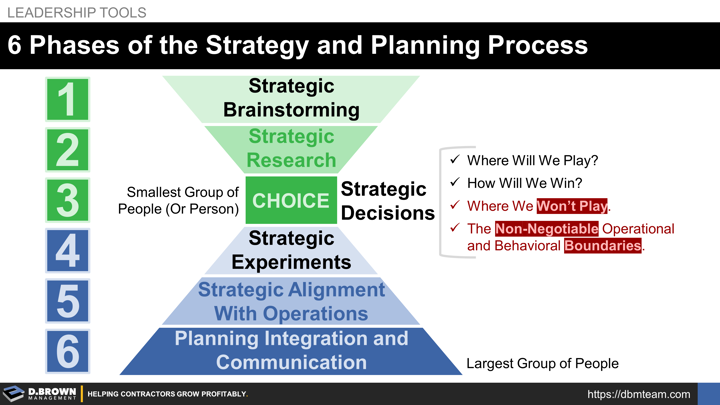Once you determine the strategy and planning objectives required for your current situation, stage of growth, and business model, then you can use this outline to further develop your plan.
We look at six general phases, though some of them may be combined, skipped, or done concurrently depending on the situation:
- Strategic Brainstorming: This involves a broad group of people as part of their development, for their perspective, to start the alignment process (phase 6), and to evaluate people for the wide range of capabilities required for all aspects of strategy, planning, execution, and communication. The outcome of this phase are "Strategic Possibilities" and questions to be worked through the process.
- Internal information on trends in projects, opportunities, customers, profits, geography, etc. over time.
- External information on market trends and economy as a whole.
- Individually studying the information provided and doing additional research.
- Developing independent ideas on opportunities and challenges in the external market (not internal operations).
- Sharing the independently developed ideas in writing and then discussing to gain common understanding across the whole group – no bad ideas. Making sure that everyone understands each other’s perspectives and their rationale.
- Strategic Research: This involves various internal or external resources as directed by the CEO and Senior Executives.
- Research the Strategic Possibilities identified for basic attributes like market size, growth rate, competitors, key people, etc. This will move them into categories for decision making.
- Research some of the information required or questions that came up to validate or invalidate assumptions that have been made.
- Strategic Decisions (Choices on Direction) + High-Level Targets (Trajectory Milestones): These are the big ones and are focused on the major market and resource allocations that are:
- Diversified enough for stability in all economic conditions.
- Large enough relative to the contractor's current size for sustained growth over a 10+ year timeframe.
- Focused enough to develop economies of scale in systems, people, and reputation.
- Strategic decisions also include boundaries on work the company WILL NOT pursue, as well as behavioral and operational limits that are non-negotiable.
- Strategic Experiments: These are a subset of your Strategic Decisions. They are clear choices on defining experiments and allocating resources to investigate markets with growth potential. These experiments, including milestone targets to decide whether to proceed forward, accelerate, revise, or close. These are generally:
- In addition to your Strategic Decisions about major markets.
- The most advanced stage of Strategic Research.
- Allocation of 10-20% of a contractor’s resources.
- Have a 20%+ probability of growing into a major market and becoming a Strategic Decision in the future.
- Strategic Alignment with Operations: This phase typically involves your highest level people leading a functional area of the company that is crucial for the Strategic Decisions including Strategic Experiments to work.
- What are the strategies and major resource commitments including people required for operational capabilities to meet the strategic targets?
- This involves the executive team with the focus being on “What must be true about operations to achieve these strategic targets?”
- Planning Integration and Communication: Tying everything together starting with Business Plans for the next 1-3 years and Operational Plans getting into the more detailed resource requirements and metrics for the next 12 months. This likely includes changes to systems, organizational structure, and tools. Communication across the whole team is critical as this phase progresses.
Please remember that these six phases look very different within different stages of growth. For example, at Stage 1, these are all done by one person. At Stage 2, these discussions are a few pizza and beer sessions around the shop.
By Stage 4, a contractor on a growth trajectory with a management team that is "Ready" will be conceptualizing the process in these six phases and will have several key people taking individual leadership roles in the business planning process for specific markets.
It is only at Stage 5 and beyond that the teams are truly starting to answer the five interlinked questions about strategy then execute against them. Stage 6+ is about further codifying this process including integrating it with talent development for sustainable growth and succession.
As a note, most of the time when we hear or see "Strategic Planning" it is a combination of phase 1 and a very diluted version of phase 6.

